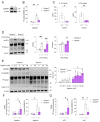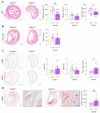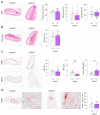Gasdermin D Deficiency Limits the Transition of Atherosclerotic Plaques to an Inflammatory Phenotype in ApoE Knock-Out Mice
- PMID: 35625908
- PMCID: PMC9138554
- DOI: 10.3390/biomedicines10051171
Gasdermin D Deficiency Limits the Transition of Atherosclerotic Plaques to an Inflammatory Phenotype in ApoE Knock-Out Mice
Abstract
Gasdermin D (GSDMD) is the key executor of pyroptotic cell death. Recent studies suggest that GSDMD-mediated pyroptosis is involved in atherosclerotic plaque destabilization. We report that cleaved GSDMD is expressed in macrophage- and smooth muscle cell-rich areas of human plaques. To determine the effects of GSDMD deficiency on atherogenesis, ApoE-/- Gsdmd-/- (n = 16) and ApoE-/-Gsdmd+/+ (n = 18) mice were fed a western-type diet for 16 weeks. Plaque initiation and formation of stable proximal aortic plaques were not altered. However, plaques in the brachiocephalic artery (representing more advanced lesions compared to aortic plaques) of ApoE-/- Gsdmd-/- mice were significantly smaller (115 ± 18 vs. 186 ± 16 × 103 µm2, p = 0.006) and showed features of increased stability, such as decreased necrotic core area (19 ± 4 vs. 37 ± 7 × 103 µm2, p = 0.03) and increased αSMA/MAC3 ratio (1.6 ± 0.3 vs. 0.7 ± 0.1, p = 0.01), which was also observed in proximal aortic plaques. Interestingly, a significant increase in TUNEL positive cells was observed in brachiocephalic artery plaques from ApoE-/- Gsdmd-/- mice (141 ± 25 vs. 62 ± 8 cells/mm2, p = 0.005), indicating a switch to apoptosis. This switch from pyroptosis to apoptosis was also observed in vitro in Gsdmd-/- macrophages. In conclusion, targeting GSDMD appears to be a promising approach for limiting the transition to an inflammatory, vulnerable plaque phenotype.
Keywords: atherosclerosis; gasdermin D; inflammation; pyroptosis.
Conflict of interest statement
The authors declare no conflict of interest.
Figures






Similar articles
-
The novel GSDMD inhibitor GI-Y2 exerts antipyroptotic effects to reduce atherosclerosis.Clin Transl Med. 2025 Mar;15(3):e70263. doi: 10.1002/ctm2.70263. Clin Transl Med. 2025. PMID: 40045452 Free PMC article.
-
Inhibition of GSDMD activation by Z-LLSD-FMK or Z-YVAD-FMK reduces vascular inflammation and atherosclerotic lesion development in ApoE-/- mice.Front Pharmacol. 2023 Aug 1;14:1184588. doi: 10.3389/fphar.2023.1184588. eCollection 2023. Front Pharmacol. 2023. PMID: 37593179 Free PMC article.
-
Gasdermin D plays a key role as a pyroptosis executor of non-alcoholic steatohepatitis in humans and mice.J Hepatol. 2018 Apr;68(4):773-782. doi: 10.1016/j.jhep.2017.11.040. Epub 2017 Dec 20. J Hepatol. 2018. PMID: 29273476
-
Structural Insight of Gasdermin Family Driving Pyroptotic Cell Death.Adv Exp Med Biol. 2019;1172:189-205. doi: 10.1007/978-981-13-9367-9_9. Adv Exp Med Biol. 2019. PMID: 31628657 Review.
-
'Hints' in the killer protein gasdermin D: unveiling the secrets of gasdermins driving cell death.Cell Death Differ. 2017 Apr;24(4):588-596. doi: 10.1038/cdd.2017.24. Epub 2017 Mar 3. Cell Death Differ. 2017. PMID: 28362726 Free PMC article. Review.
Cited by
-
Latexin deficiency limits foam cell formation and ameliorates atherosclerosis by promoting macrophage phenotype differentiation.Cell Death Dis. 2024 Oct 18;15(10):754. doi: 10.1038/s41419-024-07141-3. Cell Death Dis. 2024. PMID: 39424784 Free PMC article.
-
Disulfiram Reduces Atherosclerosis and Enhances Efferocytosis, Autophagy, and Atheroprotective Gut Microbiota in Hyperlipidemic Mice.J Am Heart Assoc. 2024 Apr 16;13(8):e033881. doi: 10.1161/JAHA.123.033881. Epub 2024 Apr 2. J Am Heart Assoc. 2024. PMID: 38563369 Free PMC article.
-
Impavido attenuates inflammation, reduces atherosclerosis, and alters gut microbiota in hyperlipidemic mice.iScience. 2023 Mar 20;26(4):106453. doi: 10.1016/j.isci.2023.106453. eCollection 2023 Apr 21. iScience. 2023. PMID: 37020959 Free PMC article.
-
The dance of macrophage death: the interplay between the inevitable and the microenvironment.Front Immunol. 2024 Mar 20;15:1330461. doi: 10.3389/fimmu.2024.1330461. eCollection 2024. Front Immunol. 2024. PMID: 38576612 Free PMC article. Review.
-
Inflammasomes and Atherosclerosis: a Mixed Picture.Circ Res. 2023 May 26;132(11):1505-1520. doi: 10.1161/CIRCRESAHA.123.321637. Epub 2023 May 25. Circ Res. 2023. PMID: 37228237 Free PMC article. Review.
References
-
- Galluzzi L., Vitale I., Aaronson S.A., Abrams J.M., Adam D., Agostinis P., Alnemri E.S., Altucci L., Amelio I., Andrews D.W., et al. Molecular mechanisms of cell death: Recommendations of the Nomenclature Committee on Cell Death 2018. Cell Death Differ. 2018;25:486–541. doi: 10.1038/s41418-017-0012-4. - DOI - PMC - PubMed
Grants and funding
LinkOut - more resources
Full Text Sources
Miscellaneous

